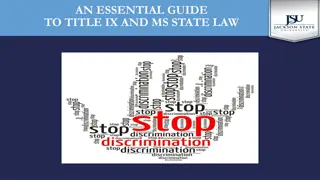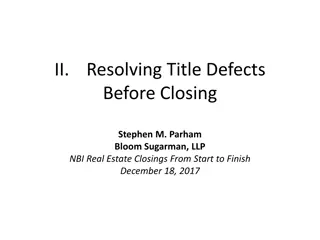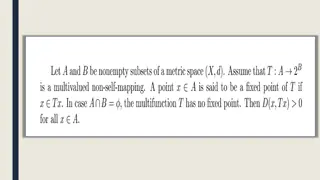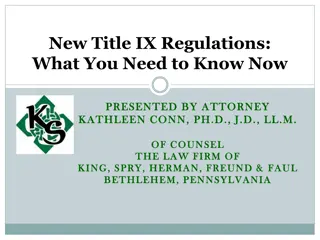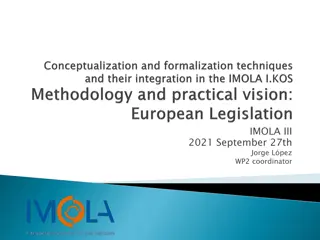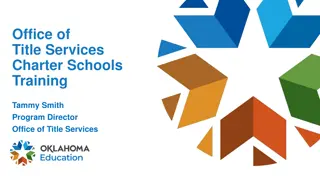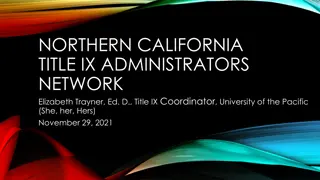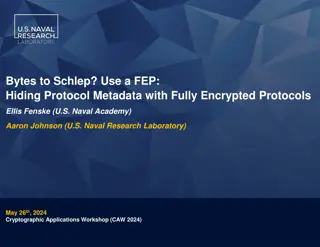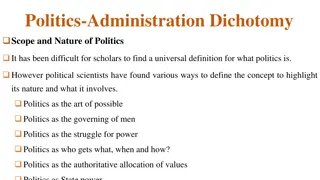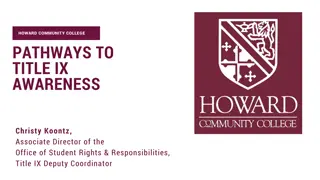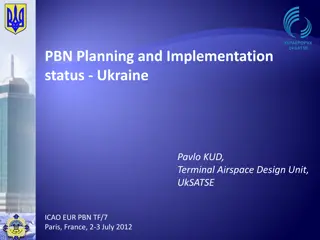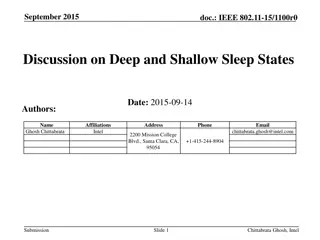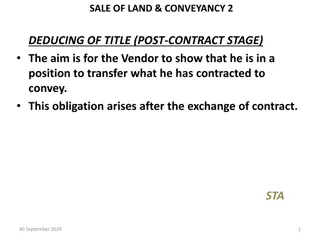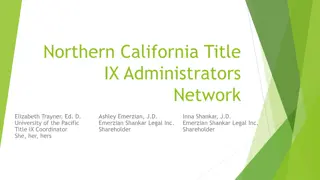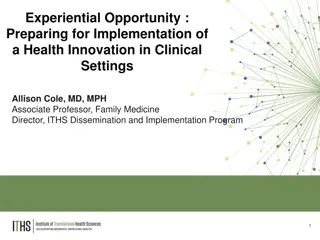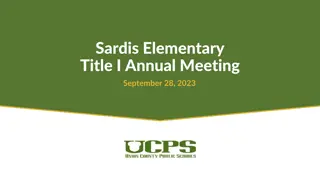Title IX: Definitions, Key Concepts, and Implementation
Explore the key definitions and concepts of Title IX, including sexual harassment, basis of sex issues, and more. Learn about the Final Rule 106.30 and how it applies to educational institutions. Get insights on the importance of defining terms like consent and incapacitation. Delve into the complexities of sexual harassment under Title IX regulations and gain clarity on prohibited conduct. The webinar series provides valuable information and resources for compliance with Title IX guidelines.
Download Presentation

Please find below an Image/Link to download the presentation.
The content on the website is provided AS IS for your information and personal use only. It may not be sold, licensed, or shared on other websites without obtaining consent from the author.If you encounter any issues during the download, it is possible that the publisher has removed the file from their server.
You are allowed to download the files provided on this website for personal or commercial use, subject to the condition that they are used lawfully. All files are the property of their respective owners.
The content on the website is provided AS IS for your information and personal use only. It may not be sold, licensed, or shared on other websites without obtaining consent from the author.
E N D
Presentation Transcript
Title IX Webinar #1 Mackenzie Wilfong and Brandee Hancock July 2020
Lets get started Agenda for the four webinars Checklist of to-dos before August 14th https://system.suny.edu/sci/news/7-1-20-title-ix-toolkit/index.html Need more information? A good place to start is the SUNY Joint Guidance https://system.suny.edu/sci/tix2020/ We are providing these presentations to you in full. Use them or modify them as you like. We will close caption these four webinars and place them in the Dropbox. 2
Key definitions The Final Rule 106.30(a) defines and applies definitions to the terms. You will want to copy these verbatim. actual knowledge, complainant, formal complaint, respondent, sexual harassment, and supportive measures. Final Rule Section 106.30 states that [t]he Assistant Secretary will not require recipients to adopt a particular definition of consent with respect to sexual assault, as referenced in this section. A recipient therefore retains the discretion to select a definition of consent that best serves the unique needs, values, and environment of its educational community. See 85 Fed. Reg. 30026, 30174 (May 19, 2020). You will want to review and keep definitions for force, coercion, consent, and incapacitation. You may want to include state definitions as an appendix like you do with your Clery Annual Security Report The joint guidance has all the definitions for you. See https://system.suny.edu/sci/tix2020/ 4
Defining sexual harassment The Final Rule 106.30 defines sexual harassment as conduct on the basis of sex that satisfies one or more of the following: (i) An employee conditioning educational benefits on participation in unwelcome sexual conduct (i.e., quid pro quo); (ii) Unwelcome conduct that a reasonable person would determine is so severe, pervasive, and objectively offensive that it effectively denies a person equal access to the educational institution s education program or activity; or (iii)Sexual assault (as defined in the Clery Act), or dating violence, domestic violence, or stalking as defined in the Violence Against Women Act (VAWA).The joint guidance has all the definitions for you. See https://system.suny.edu/sci/tix2020/ 5
Basis of sex issue In the preamble to the Final Rule, the Department includes language aimed at clarifying that the term sex is not defined at all in the Title IX statute or existing regulations, and that the Department declines to define it with the Final Rule. The Department explains that the focus of the Final Rule is on prohibited conduct and any individual irrespective of sexual orientation or gender identity may be victimized by the type of conduct defined as sexual harassment. See 85 Fed. Reg. at 30178. This is consistent with recent Title VII interpretations by the U.S. Supreme Court in Bostock v. Clayton County. 6
Quid pro quo and VAWA The Department created a definition where quid pro quo harassment and the four Clery Act/VAWA offenses (sexual assault, dating violence, domestic violence, and stalking) constitute per se actionable sexual harassment that do not require an evaluation for severity, pervasiveness, and objectiveness, or denial of equal educational access, because prohibiting such conduct presents no First Amendment concerns and such serious misconduct is assumed to cause denial of equal education. 7
Ands and Ors matter The Severe, Pervasive, and Objectively Offensive Standard applies a more difficult standard to meet than had been required in previous Departmental guidance. Why the higher standard? The DOE stated that this could cover conduct that raises First Amendment concerns (i.e., purely verbal conduct), and these elements [all together] are necessary to ensure that speech and expressive conduct is not peremptorily chilled or restricted, yet may be punishable when the speech becomes serious enough to lose protected status under the First Amendment (i.e., where the speech is so severe, pervasive, and objectively offensive as to effectively deny equal access to education). See 85 Fed. Reg. at 30151 (emphasis added). DOE specifically rejected the application of Title VII s standard of severe or pervasive, arguing the differences between an educational and workplace environment warrant a different standard, and that the Supreme Court has rejected the idea that First Amendment protections should apply with less force in the educational setting. See Id. at 30151. 8
Educational Program or Activity Only applies to sexual harassment in an education program or activity of the recipient against a person in the United States Includes locations, events, or circumstances over which the recipient exercised substantial control over both the respondent and the context in which the sexual harassment occurs Includes any building owned or controlled by a student organization that is officially recognized by a postsecondary institution Complainant must be participating in, or attempting to participate in, the recipient s educational program or activity at the time of filing a Formal Complaint 10
Off-Campus Conduct Study abroad excluded (no extraterritorial application) Off-campus conduct covered if any of three conditions are met: The off-campus conduct occurs as part of the recipient s operations; The recipient exercised substantial control over the respondent AND the context of alleged sexual harassment that occurred; or The incident occurred at an off-campus building owned or controlled by a student organization officially recognized by the institution Does not matter if recipient exercised substantial control over the respondent officially recognizing the student organization is enough Substantial control no single factor is determinative, but consider whether the recipient funded, promoted, or sponsored the event or circumstance where the alleged harassment occurred 11
Online Harassment Program or activity includes all operations, which may certainly include computer and internet networks, digital platforms, and computer hardware or software owned or operated by, or used in the operations of, recipient. But does an institution have substantial control over a student while studying remotely? No direct answer. A student using a personal device to perpetrate online sexual harassment during class time may constitute a circumstances over which the recipient exercises substantial control. 12
Reports versus Formal Complaints
Report Does not trigger Title IX investigative or hearing process Informs institution, which triggers offer of supportive measures Required to provide complainant with information about supportive measures (available with or without Formal Complaint), and explain the process of filing a Formal Complaint Can be filed by anyone Does not have to be in writing Could include oral report, written report, personal observation, a newspaper article, an anonymous report, or other various means. 14
Formal Complaint Defined as a document filed by a complainant or signed by the Title IX Coordinator alleging sexual harassment against a respondent and requesting that the recipient investigate the allegation of sexual harassment Institution can have a specific form, but cannot require a complainant use that form as long as complaint is physically or digitally signed May only be filed by the alleged victim or the Title IX Coordinator Does not require a detailed statement of facts No time limit Cannot be anonymous 15
Formal Complaint Title IX Coordinator can file when they believe an investigation is required in order to not be deliberately indifferent and Complainant does not wish to participate Factors to consider: Pattern of alleged misconduct by a particular respondent Use of violence Use of weapons Other similar factors Can occur only after Title IX Coordinator has talked to Complainant about supportive measures, considered the Complainant s requests, and explain the process for filing a Formal Complaint Still required to provide notice to both parties 16
Emergency Removals
Interim Suspensions now called Emergency Removals Section 106.44(c) of the Final Rule imposes a high threshold to justify the emergency removal of a respondent whether a student or employee from an education program or activity. This is likely not how your institution matriculated interim suspensions previously. An emergency removal is not tantamount to a determination of responsibility or a sanction. An emergency removal must not effectuate, in any way, a pre-judging of the allegations against the respondent, who is entitled to a presumption of non- responsibility pending the completion of a grievance process under 106.45. The Department states that it will not second-guess an emergency removal decision under 106.44(c), provided that the institution has adhered to the requirements to support its action and even if the Department would have weighed the evidence of risk differently. Draft your policy and follow it Need help, review https://system.suny.edu/media/suny/content- assets/documents/sci/tix2020/Emergency-Removal.pdf 18
Emergency Removals Steps 1-2 Step 1: Conduct a prompt individualized safety and risk analysis What group will you use to assess this? While this section does not override any existing institutional structures for evaluating risk (like a BIT), it makes clear that all designated personnel must be free of bias and avoid conflicts of interest, and their involvement in the removal analysis could preclude their later participation in the grievance process. According to the August 24, 2016 DCL on the privacy of student medical records, members of a threat assessment team are typically considered school officials under FERPA who may make use of the school official exception to consent to disclosure of FERPA-shielded information. https://studentprivacy.ed.gov/sites/default/files/resource_document/file/DCL_Medical%20Records_Final%20Signed_dated_9-2.pdf Step 2: Make the required finings using objective measures (BIT should have this) Immediate threat The analysis should assess the respondent s propensity, opportunity, and ability to effectuate a stated or potential threat. Would supportive measure work just as well? Concept of least restrictive measures borrowed from K-12. To the physical health or [physical] safety of any student or other individual The immediate threat must be to the physical health or [physical] safety of one or more individuals, who may be the respondent, the complainant, or any other individual (such as a third-party witness). Purposefully designed to ensure that the emergency removal provision is not used inappropriately to prematurely punish respondents by relying on a person s mental or emotional health or safety to justify an emergency removal, as the emotional and mental well-being of complainants may be addressed by recipients via supporting measures . . . . 85 Fed. Reg. 30225 (May 19, 2020). Challenging factual evaluations will arise in the assessment of conduct such as speech, text messages, and social media. May want to look at updating your threat assessment tools including the Violence Risk Assessment of the Written Word (VRAW2). See https://www.nabita.org/resources/vraw2/ and other objective threat assessment tools. Need help, review https://system.suny.edu/media/suny/content-assets/documents/sci/tix2020/Emergency-Removal.pdf 19
Emergency Removals Steps 3-5 Step 3: Evaluate the applicability of disability laws to the removal decision Step 4: Consider the appropriateness of supportive measures in lieu of an emergency removal Department emphasizes that [s]upportive measures prove one avenue for [institutions] to protect the safety of parties and permissibly may affect and even burden the respondent, so long as the burden is not unreasonable. 85 Fed. Reg. at 30231. Consider a partial exclusion from specific programs or activities. The Department has not imposed any temporal limitation on the term of the emergency removal, but nothing in the regulations precludes an institution from conducting interim assessments of whether the immediate threat to physical health or safety of a student or another individual remains unchanged or has sufficiently dissipated to support the respondent s return to programs or activities wholly or partially. Step 5: Provide the respondent with notice and an immediate opportunity to challenge the emergency removal If there is no real exigency justifying a suspension without notice, and the institution wants to maintain a suspension for a lengthy period prior to a final determination, due process requires something more than an informal interview with an administrative authority of the college. Haidak v. Univ. of Massachusetts-Amherst, 933 F.3d 56, 72 (1st Cir. 2019) (internal quotation marks omitted.) See the model emergency removal policy language for the challenge process. If Title IX Coordinator is not the investigator and won t be on a hearing panel, then they can do supporting measures and emergency removal challenges. 20
Dismissal of formal complaint
Dismissal of formal complaints - Must Dismissal is determined after you have a formal complaint Upon any dismissal, you must promptly send written notice of the dismissal and the rationale for doing so simultaneously to the parties. This dismissal decision is appealable by any party under the procedures for appeal. The decision not to dismiss is also appealable by any party claiming that a dismissal is required or appropriate. A Complainant who decides to withdraw a complaint may later request to reinstate it or refile it. Formal complaint must be dismissed (from the Title IX process) if conduct (34 CFR Part 106.45): Did not occur in institution s program/activity (you will want to define this term in your policy) Locations, events, or circumstances in which an institution exercises substantial control over both the respondent and the context in which the sexual harassment occurs Locations include buildings owned or controlled by officially recognized student organizations. 106.44(a) Did not occur against a person in the United States (study abroad). If the conduct happened outside the U.S. you must dismiss. Would not constitute sexual harassment even if proved. 22
Dismissal of formal complaints - May Formal complaint may be dismissed (from the Title IX process): If complainant requests to withdraw their complaint The Department explained its view that complainants should have the autonomy to decide whether or not they would like to proceed with or withdraw a formal complaint of sexual harassment. When a College or University receives a complainant s withdrawal request during the investigation or hearing, the recipient may dismiss the complaint or may decide to continue with the investigation and hearing. When a complainant submits a written withdrawal to the Title IX Coordinator, a recipient may choose to continue with the investigation in certain situations. The Department gave as examples: when the information obtained supports that the respondent may pose an ongoing risk to the recipient s community, where the recipient has gathered evidence apart from the complainant s statements and desires to reach a determination regarding the respondent s responsibility, when a determination regarding responsibility provides a benefit to the complainant even where the recipient lacks control over the respondent and would be unable to issue disciplinary sanctions, or other reasons. 85 Fed. Reg. 30290. 23
Dismissal of formal complaints May Formal complaint may be dismissed (from the Title IX process): If respondent is no longer enrolled or employed because the respondent is a non-student, non-employee individual who came onto campus and allegedly sexually harassed a complaint, and the recipient has no way to gather evidence sufficient to make a determination. 85 Fed. Reg. 30290. 24
Dismissal of formal complaints - May Formal complaint may be dismissed (from the Title IX process): When specific circumstances prevent gathering evidence sufficient to reach a determination In the preamble, the Department offered the following examples of situations that may present special circumstances supporting dismissal: When no complainant is identified during the investigation. The Department explained, [W]ithout knowing a complainant s identity a recipient may not be able to gather evidence necessary to establish elements of conduct defined as sexual harassment under 106.30, such as whether alleged conduct was unwelcome, or without the consent of the victim. 85 Fed Reg. 30133 n. 594. When a formal complaint contains allegations that are precisely the same as allegations the recipient has already investigated and adjudicated. 85 Fed. Reg. 30214 n. 939. When the length of time elapsed between an incident of alleged sexual harassment, and the filing of a formal complaint, prevent a recipient from collecting enough evidence to reach a determination. 85 Fed. Reg. 30214. When the complainant has stopped participating in the investigation but has not sent a written withdrawal request and the only inculpatory evidence available is the complainant s statement in the formal complaint or as recorded in an interview by the investigator. 85 Fed. Reg. 30282 and 30290. The Department emphasized that this provision is not the equivalent of a recipient deciding that the evidence gathered has not met a probable or reasonable cause threshold or other measure of the quality or weight of the evidence, but rather is intended to apply narrowly to situations where specific circumstances prevent the recipient from meeting its burden in 106.45(b)(5)(i) to gather sufficient evidence to reach a determination. 85 Fed. Reg. 30290. 25
Dismissal of formal complaints - Notice The Final Rule requires that for any dismissal, mandatory or permissive, a recipient must promptly send written notice of the dismissal and reason(s) therefor simultaneously to the parties. The Final Rule, in 106.45(b)(8)(i), provides either party may submit a request to appeal the dismissal of a formal complaint or allegations therein of sexual harassment. Under the Final Rule, appeal bases must include: procedural irregularity, new evidence, and conflict of interest or bias on the part of the Title IX Coordinator, investigator(s), or decision-maker(s). Note this is the floor, not the ceiling. You could add other reasons for appeal. 26
Informal resolutions are optional
Informal resolution ground rules Offering or use of informal resolutions by an institution is not required by the Final Regulations, your institution needs to make a choice do you want to use it or not. The policies you will need to write are significant, you need to make that choice soon. You cannot mandate mediation in policies as a predicate to enrollment or employment. You cannot include a mandatory mediation clause in a handbook. Section 106.45(b)(9) Informal resolution may only be offered after a formal complaint has been filed, so that the parties understand what the grievance process entails and can decide whether to voluntarily attempt informal resolution as an alternative. Why bother? Through an informal resolution process a recipient may impose disciplinary sanctions against a respondent without concluding an investigation or adjudication. 28
Informal resolution notice At any time prior to reaching a determination regarding responsibility the recipient may facilitate an informal resolution process, such as mediation, that does not involve a full investigation and adjudication, if all three of the below occur Provides to the parties a written notice disclosing all of the following the allegations, the requirements of the informal resolution process including the circumstances under which it precludes the parties from resuming a formal complaint arising from the same allegations. any party has the right to withdraw from the informal resolution process and resume the grievance process with respect to the formal complaint any consequences resulting from participating in the informal resolution process, including the records that will be maintained or could be shared For example, the College can prohibit a mediator from being a witness later via policy. Obtains the parties voluntary, written consent to the informal resolution process; and Does not offer or facilitate an informal resolution process to resolve allegations that an employee sexually harassed a student. 85 Fed. Reg. 30054 (May 19, 2020). 29
Informal resolution facilitator Informal resolution facilitator must receive training on: the definition of sexual harassment under 106.30(a); the scope of the institution s education program or activity; how to conduct informal resolution processes; and how to serve impartially, including by avoiding prejudgment of the facts at issue, conflicts of interest, or bias. The final regulations permit, but do not require, recipients to outsource informal resolutions to third party providers. See 85 Fed. Reg. at 30405. 30
Informal resolution agreements The Department is clear that under 106.45(b)(9), an informal resolution may result in the parties, and the University/College, agreeing on a resolution of the allegations of a formal complaint that involves punishing or disciplining a respondent. The Department explains that if expulsion is the sanction proposed as part of an informal resolution process, that result can only occur if both parties agree to the resolution. The Department notes that if a respondent, for example, does not believe that expulsion is appropriate then the respondent can withdraw from the informal resolution process and resume the formal grievance process. 106.45(b)(9). See 85 Fed. Reg. at 30407. 31


